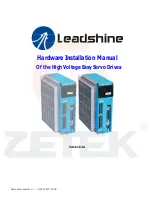
250
Learning Advanced Features
•
If the auto restart number is set, be careful when the inverter resets from a fault trip. The motor
may automatically start to rotate.
•
In HAND mode, auto restart resets the trip condition but it does not restart the inverter operation.
•
In AUTO mode,
-
if the auto restart is configured, the inverter restarts after a trip condition is released
(command via digital input is used to restart the operation).
-
if the auto restart is not configured and the trip condition is released using the OFF key,
or the switches at the terminal input, the inverter stays in the OFF state. Because the
command information is reset along with the trip condition, a new command is required
to operate the inverter.
5.29
Operational Noise Settings (Carrier Frequency
Settings)
Group
Code
Name
LCD Display
Parameter Setting
Setting
Range
Unit
CON
04
Carrier Frequency Carrier Freq
3.0 0.75~90kW
1.0–15.0
kHz
2.0 110~355kW
1.0~5.0
1.5 400/500kW
1.0~4.0
05
Switching Mode
PWM* Mode
0
Normal PWM
0–1
-
* PWM: Pulse width modulation
Operational Noise Setting Details
Code
Description
CON-04
Carrier Freq
Adjusts motor operational noise by changing carrier frequency settings. Power
transistors (IGBT) in the inverter generate and supply high frequency switching
voltage to the motor. The switching speed in this process refers to the carrier
frequency. If the carrier frequency is set high, it reduces operational noise from
the motor. If the carrier frequency is set low, it increases operational noise from
the motor.
CON-05 PWM
Mode
The heat loss and leakage current from the inverter can be reduced by changing
the load rate option at CON-05 (PWM Mode). Selecting ‘1 (LowLeakage PWM)’
reduces heat loss and leakage current, compared to when ‘0 (Normal PWM)’ is
selected. However, it increases the motor noise. Low leakage PWM uses a 2
Summary of Contents for 6731001500
Page 1: ......
Page 17: ...Preparing the Installation 4 37 90kW 3 Phase ...
Page 18: ...Preparing the Installation 5 110 132kW 3 Phase ...
Page 19: ...Preparing the Installation 6 160 185kW 3 Phase ...
Page 20: ...Preparing the Installation 7 220 250kW 3 Phase ...
Page 21: ...Preparing the Installation 8 315 400kW 3 Phase ...
Page 22: ...Preparing the Installation 9 500kW 3 Phase ...
Page 34: ...21 Installing the Inverter 400 V 220 500kW ...
Page 50: ...37 Installing the Inverter Inputand OutputControlTerminalBlockWiringDiagram 5 5 90kW ...
Page 66: ...Perform BasicOperations 53 ...
Page 106: ...93 Learning BasicFeatures 0 10V InputVoltageSettingDetails V1 Quantizing ...
Page 107: ...94 Learning BasicFeatures ...
Page 187: ...174 Learning Advanced Features PIDCommandBlock ...
Page 188: ...175 Learning Advanced Features ...
Page 189: ...176 Learning Advanced Features PIDFeedbackBlock ...
Page 190: ...177 Learning Advanced Features PIDOutputBlock ...
Page 191: ...178 Learning Advanced Features PIDOutputModeBlock ...
Page 205: ...192 Learning Advanced Features EPID1Controlblock ...
Page 206: ...193 Learning Advanced Features EPID2Controlblock ...
Page 228: ...215 Learning Advanced Features ...
Page 244: ...231 Learning Advanced Features TheTime Chartfor the Exception Day ...
Page 260: ...247 Learning Advanced Features SpeedSearchOperation SettingDetails ...
Page 405: ...392 RS 485 Communication Features 7 3 9 2 Control Area Parameter Read Write ...
Page 555: ...Table ofFunctions 542 8 16 4 CoolingTower MC4 Group ...
Page 558: ...Tableof Functions 545 8 16 5 Circulation Pump MC5 Group ...
Page 562: ...Tableof Functions 549 8 16 6 Vacuum Pump MC6 Group ...
Page 588: ...575 Troubleshooting ...
Page 608: ...TechnicalSpecification 595 11 3 External Dimensions 0 75 30kW 3 phase 37 90kW 3 phase ...
Page 609: ...TechnicalSpecification 596 110 185kW 3 phase ...
Page 632: ...TechnicalSpecification 619 400 V 37 500 kW Current Derating Rate ...
Page 643: ...630 ...
Page 644: ...631 ...
Page 645: ...632 ...
















































